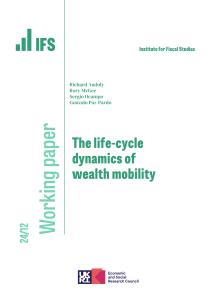This article estimates the importance of temptation for consumption smoothing and asset accumulation in a life‐cycle model. We use two complementary estimation strategies: first, we estimate the model‐implied Euler equation; second, we match liquid and illiquid wealth accumulation using the method of simulated moments. In both cases, we find that the utility cost of temptation is one‐quarter of the utility benefit of consumption. Further, temptation is crucial for correctly estimating the elasticity of intertemporal substitution (EIS): EIS estimates are biased downward when ignoring temptation. Finally, the model only matches the share of illiquid wealth if temptation is in the preference specification.
Authors

Research Fellow University of Oxford
Hamish is the James Meade Professor of Economics at the University of Oxford, a Professorial Fellow of Nuffield College and a Research Fellow at IFS.

Research Fellow University of Copenhagen
Patrick is a Research Fellow at the IFS, an Assistant Professor of Economics at the University of Copenhagen and a faculty member in the CEBI.

Research Associate University of Manchester
Agnes is an applied economist who uses economic models and micro-level data to better understand the consumption and savings behaviour of households.
Journal article details
- DOI
- 10.1111/iere.12491
- Publisher
- Wiley
- Issue
- Volume 62, Issue 1, October 2020, pages 101-139
Suggested citation
A, Kovacs and H, Low and P, Moran. (2020). 'Estimating temptation and commitment over the life cycle' 62(1/2020), pp.101–139.
More from IFS
Understand this issue

Raising revenue from closing inheritance tax loopholes
18 April 2024

Why inheritance tax should be reformed
18 January 2024

How important is the Bank of Mum and Dad?
15 December 2023
Policy analysis

ABC of SV: Limited Information Likelihood Inference in Stochastic Volatility Jump-Diffusion Models
We develop novel methods for estimation and filtering of continuous-time models with stochastic volatility and jumps using so-called Approximate Bayesian Compu- tation which build likelihoods based on limited information.
12 August 2014

Reforming the taxation of non-doms: policy options and uncertainties
4 March 2024

Social mobility and wealth
Academic research

Understanding Society: minimising selection biases in data collection using mobile apps
2 February 2024

The life-cycle dynamics of wealth mobility
10 April 2024

House price rises and borrowing to invest
27 March 2024